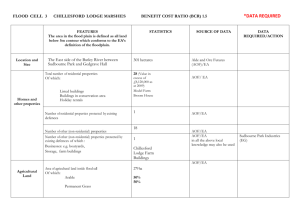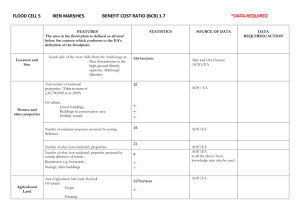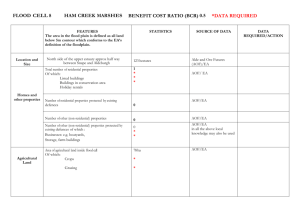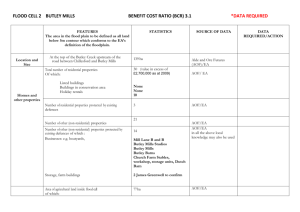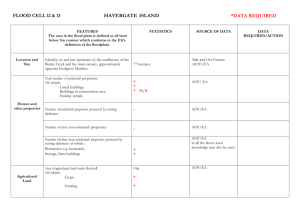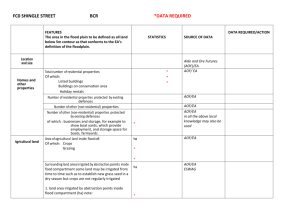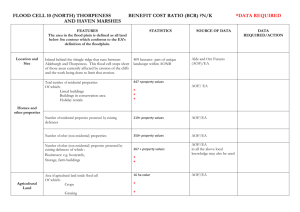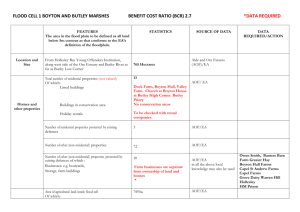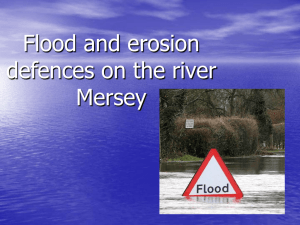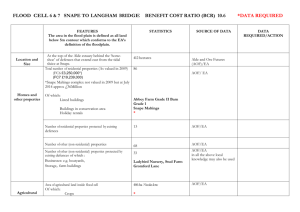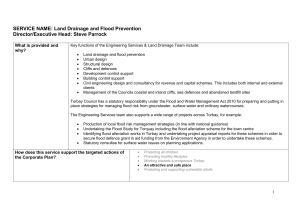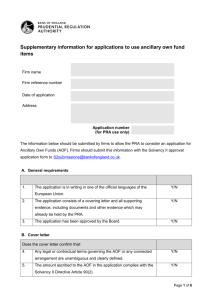FC9 - Hazelwood - Suffolk Coast and Heaths
advertisement
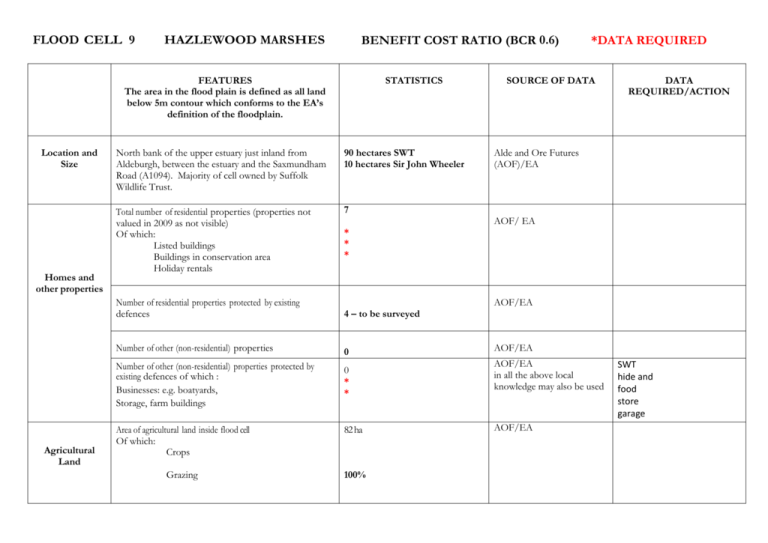
FLOOD CELL 9 HAZLEWOOD MARSHES BENEFIT COST RATIO (BCR 0.6) FEATURES The area in the flood plain is defined as all land below 5m contour which conforms to the EA’s definition of the floodplain. Location and Size Homes and other properties Agricultural Land STATISTICS North bank of the upper estuary just inland from Aldeburgh, between the estuary and the Saxmundham Road (A1094). Majority of cell owned by Suffolk Wildlife Trust. 90 hectares SWT 10 hectares Sir John Wheeler Total number of residential properties (properties not valued in 2009 as not visible) Of which: Listed buildings Buildings in conservation area Holiday rentals 7 * * * Number of residential properties protected by existing defences 4 – to be surveyed Number of other (non-residential) properties 0 Number of other (non-residential) properties protected by existing defences of which : Businesses: e.g. boatyards, Storage, farm buildings 0 * * Area of agricultural land inside flood cell Of which: Crops 82 ha Grazing 100% *DATA REQUIRED SOURCE OF DATA DATA REQUIRED/ACTION Alde and Ore Futures (AOF)/EA AOF/ EA AOF/EA AOF/EA AOF/EA in all the above local knowledge may also be used AOF/EA SWT hide and food store garage Surrounding land area irrigated by abstraction points inside flood cell 1. Land area irrigated by abstraction points inside flood cell (ha) note: 2. Land irrigated outside any flood cell from abstraction point within cell 3. Other economically useful land such as golf course, allotments Wildlife and Habitat 4. Recreation grounds Hazelwood Marshes incorporate the entire area of flood cell 9. They were among the last undrained permanent wet grassland sites on the Suffolk coast. Grazed principally with cattle and an occasional small flock of sheep. Most fields are in the HLS option. The importance of this site is that very little drainage improvement had been attempted since its ‘inning’ from the estuary sometime around 1850. Therefore most of the drainage ditches follow the original saltmarsh creeks. A notable Anglo-Saxon site has been excavated on several occasions in sited on Barber’s Point. Several nationally rare and scarce freshwater invertebrates were found within the ditches running through Hazelwood Marshes. Three sides of the flood cell abut the River Alde/Ore which is part of the network of the Alde/Ore/Butley Estuaries, a designated SAC (Special area of Conservation) and contains habitats of conservation concern (see the more detailed description at Annex 1). Large parts of the flood cell are owned and managed by Suffolk Wildlife Trust. The site was internationally designated for freshwater features that rely on the presence of the flood defences to avoid damage that may otherwise be caused by salt water inundation. Intertidal habitat in front of the defences is also internationally designated. AOF/EA ESWAG some land may be irrigated from time to time such as to establish new grass seed in a dry season but crops are not regularly irrigated 52 ha 250 acres of golf land irrigated * Reassessment following surge due to catastrophic inundation. Currently Intertidal EA? NE? EA?NE? ANOB SWT Wild life survey 2012 ‘Ecological assessmentAlde and Ore Estuaries’ Designations: 1. Intertidal habitat in front of defences a. saltings b. mudflats 2. Pilot schemes to renew Saltings 3. Land behind the defences. List special features/species e.g. Wildlife habitat in floodplains behind the walls including ditches with reed buntings, little grebe and kingfisher, fields with hares, flight area of barn and short eared owls, range of birds including lapwing, egret, swans, varieties of gulls (ref: Wild life/Hinterland survey on a section covering all the estuary although each FC may have its own special species). Mostly the species will be the same, but with certain exceptions, e.g. breeding avocets in FC5. 4. Higher Level Stewardship Scheme 5. Other? Not much saltmarsh hence breaches In principle yes to pilot Westemond??? * Priority species include; Common toad Bufo bufo Adder Vipera berus Common lizard Zootoca vivipara Northern lapwing Vanellus vanellus Reed bunting Emberiza schoeniclus Linnet Carduelis cannabina Skylark Alauda arvensis European otter Lutra lutra ?Water vole Arvicola terrestris Water shrew Neomys fodiens Priority habitats include; Coastal and floodplain grazing marsh (including dykes) Other breeding birds of importance European marsh harrier Circus eruginos Pied avocet Recurvirostra avosetta Bearded Tit Panurus biamicus Winter assemblages of birds include; White-fronted Goose Anser albifrons Wigeon Anas Penelope Black-tailed Godwit Limosa limosa Yes but no longer ELS Defences were earth embankments: riverward and landward faces are relatively steep in places. The walls provide a low standard of protection. In the December surge 2013 the walls were breached and the marsh is now regularly flooded and can no longer be considered a freshwater marsh. Defences A&O Futures Assessment 2011 Features dependent on the maintenance of the river walls Proposed Approach Length of sea/estuary walls 0.9 Kilometres How soon will major work be required? n/a Current Standard of Protection (the chance of flooding in any year) none Currently managed by EA 1. Footpaths in total 0Km *km *km a) along river walls (km) b) providing access to river walls but in floodable area 2. Allotments 3. Boatyards for building, repairs, winter storage 4. Public car parks 5. Sailing clubs 6. Utilities e.g. Sewage outlet (Anglian water, electricity station?) 7. Wildlife 8. Roads 9. River management and moorings 10. Employment: Jobs at risk if area is flooded 11. Other features to be invited in consultation * Hectares or Nos * * * * * * * * AOF/EA 2011 Community landowners and golf club and SWT waiting for a sustainable SOP for properties – under discussion AOF/EA AOF/ SCC Rights of Way Dept Local knowledge and SCC? Local Local Not public ROW Marine access needs to be limited and signage required Local knowledge Anglian, EON? SWT report Highways Dept? Crown Estates, sailing clubs, watermen Local knowledge A&O Futures Approach: Although in 2011 it was thought the remaining life of the defence was 5 years the EA had hoped to maintain the walls in the short term (up to about 17-20 years) and would be developing compensatory habitats which, when established, they would cease maintaining. AOEP Approach: Major breaching resulted during the 2013 surge and the entire site remains inundated. The EA have confirmed that there will be no funding to reinstate the defences and there will not be a requirement to reinstate the marsh elsewhere. Various options/costs of bunds to protect local residents and the Golf Course Riverside fairways are under discussion with all concerned. Reinstatement of the wall is not available due to the cost (approx £2M) so the freshwater marsh is lost. There may be a cost in helping to establish a salt marsh. A new local defence to protect business and properties if the site is to remain intertidal. Funding will be required and EA funds not applicable. Other benefits e.g. to local economy + ?.... + under ?.... MUST BE RECOGNISED BLANK FOR OTHER COMMENTS Localised property protection – time line – short term local protect/ long term raise funds This site can deliver intertidal habitat which benefits the wider estuary. (env + flood risk) As landowners are prepared to ‘give up’ something for greater good of AOEP plan funding support should be sought from a range of sources and partnerships support required. - local property/levee survey - initial property protection urgent – enabling development ?AOEP - Andrew Hawes to provide design for a NIS wall to separate the SWT area from private landowner + Golf Club – Visitor /local opportunity LEP other funding sources If the site is developed as an intertidal site then funding for additional car parking is reauired. Crown estate issue needs to be addressed asap
